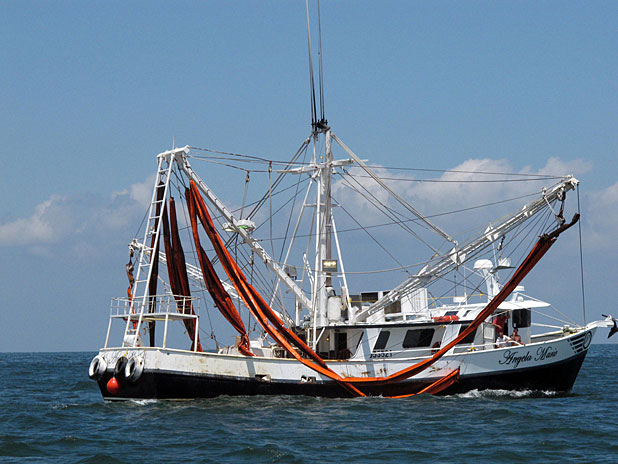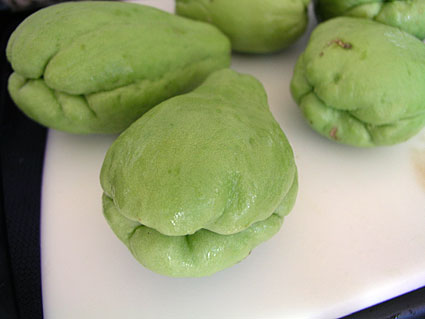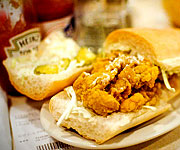 Normally this Louisiana boat would be trawling for shrimp, not oil(Photo courtesy Juanita Constible via Flickr)
Normally this Louisiana boat would be trawling for shrimp, not oil(Photo courtesy Juanita Constible via Flickr)
With more than 20 million gallons of oil already let loose in the Gulf of Mexico, fishermen, gator hunters and even farmers are waking up to the fact that the diversity of foods they depend upon for their livelihoods is imperiled. This month, the Renewing America’s Food Traditions (RAFT) alliance will release a comprehensive checklist of over 240 place-based foods of the Gulf Coast that are now at risk — 138 of them directly affected by the oil spill.
In particular, of some 136 species or stocks of fish and shellfish from the Gulf that have been historically featured in regional seafood markets and restaurants, 125 are projected to have been directly impacted by oil contamination. Because Gulf Coast communities harvest well over half of all oysters eaten in the U.S., as well as generate much of the wild-caught shrimp, grouper, redfish, and crawfish produced in North America, the oil spill is likely to diminish the overall diversity in the American food system.
Unfortunately, this crisis is not just an environmental one, but a food justice one. The spill is economically devastating to some of the most marginalized ethnic communities in the United States, including Cajun, Houma Indian, “Creole” Black, Vietnamese, Cambodian, and Latino communities in and near the Mississippi delta. And while most U.S. agencies and media have sidestepped this issue, Cuban and Mexican fishermen are just likely as Gulf Coast residents to be have their livelihoods disrupted by the oil spill.
“Many fishermen worry they may lose their livelihoods, as well as the livelihoods they intended to pass on to their progeny. Untold numbers of plants and animals — not just single lives, but possibly entire species — are now in danger and dying,” says Sara Roahen, author of Gumbo Tales. “And yet, an urban New Orleanian like me can’t help but also worry for the boiled crabs, speckled trout amandine, char-grilled oysters and, especially, seafood gumbo. I fear for the recipes, for the dishes and for the unchecked joy that hovers over every inch of the Gulf Coast as its citizens prepare and eat them.”
While most observers understand that fish, shrimp, oysters, and clams are being threatened by the Deepwater Horizon disaster, RAFT is warning of longer-term impacts that affect not only the seafood industry, but farmers, market gardeners, gator hunters, crawfish harvesters, and sassafras foragers as well. Some of the rural parishes of the Gulf Coast have already lost five out of ten residents in their communities due to out-migration following Hurricanes Katrina and Rita; if the current closures of fisheries trigger further out-migration, then rare heirloom seeds, fruits, and tubers will be abandoned in gardens, orchards, and storage sheds without anyone to grow or eat them.
 The mirliton is a rare Louisiana heirloom squash variety.(Photo courtesy of Tim in sanhazzay via Flickr)Case in point: the traditional Louisiana mirliton, the rare heirloom variety of chayote squash, which is often stuffed with shrimp and featured in Cajun and Creole restaurants, feasts, and music festivals.
The mirliton is a rare Louisiana heirloom squash variety.(Photo courtesy of Tim in sanhazzay via Flickr)Case in point: the traditional Louisiana mirliton, the rare heirloom variety of chayote squash, which is often stuffed with shrimp and featured in Cajun and Creole restaurants, feasts, and music festivals.
Lance Hill of the Adopt-a-Mirliton project based in New Orleans explains how the impact on the mirliton demonstrates the complex relationships between technology, food, culture, and community: “The dearth of shrimp will help put the mirliton out of business. The loss of coastal land will reduce the available land for commercial growers. The decline of the bayou life, where fishing and mirliton-growing went hand in hand, will diminish as well.”
The mirliton is only one of three dozen heirloom vegetables now at risk in the Gulf Coast. Louis Michot of the Cultural Resource Institute of Acadiana (CRIA) is now organizing workshops for Cajun and Houma gardeners and farmers to organize community seed banks so that these garden crops may remain safeguarded as part of their cultures and diets.
CRIA has already succeeded in obtaining quantities of some of these varieties to preserve in its Acadiana Seed Bank, but many more have yet to be collected. “While we are continuing efforts to seek out the keepers of these imperiled food resources, the crude oil leaking into the Gulf of Mexico is likely to make this time-sensitive task even more difficult,” says Michot, who is also a Cajun fiddler and lead singer for the Grammy-nominated Lost Bayou Ramblers. “The oil spill directly affects these communities by severely impacting their ability to continue farming or gardening on coastal lands, and making a living off the once sustainable but now endangered seafood industry.”
Because of these potential cultural and ecological losses, food activists are now preparing to nominate New Orleans as a World City of Gastronomy, appealing to the United Nations Educational, Scientific and Cultural Organization (UNESCO) to recognize that the widely celebrated heritage of the Gulf Coast’s food communities is in “urgent need of safeguarding.” The goal is to use a UNESCO designation as a means for the ecological restoration and market recovery of the most unique foods of the Gulf Coast region, so that its fishers, foragers, and farmers may economically survive the third major onslaught they have suffered in fewer than five years.
One tangible step that consumers can take to help Gulf Coast communities recover is to commit to purchasing the seafood and vegetables that the region’s food producers are able to get to market.
“Society at large needs to know now, more than ever, that Louisiana seafood is safe and available,” urges Christina Gerica of Gerica Seafoods in New Orleans. “Sure, some fishermen have chosen to work with the oil rigs and some fear that even temporary closures may put them out of business, but the majority are still working hard to supply the market. Like with our responses to Hurricanes Katrina and Rita, those of us that are still able to harvest, will. Our favorite traditional harvesting locations may not be as accessible, but there is still plenty seafood out there to be caught.
 Slideshow: Eat Gulf Seafood to Save It(Photo: Blissful_Bee/Flickr)“Fishermen still need to provide for their families, and that’s how all of you reading this can help.”
Slideshow: Eat Gulf Seafood to Save It(Photo: Blissful_Bee/Flickr)“Fishermen still need to provide for their families, and that’s how all of you reading this can help.”
As Slow Food New Orleans activist Poppy Tooker has proclaimed, “Now more than ever before, ‘Eat it to save it’ should be our rallying cry!”
You can download the RAFT Checklist of Gulf Coast Foods at Risk from Grist [PDF] or via my website. By the start of July, a full publication with essays by some of the sources quoted above will be available from the RAFT Alliance and an updated link on this post.



